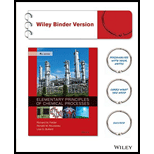
(a)
Interpretation:
If the given process is found as continuous, batch or semibatch and if it is in transient or steady state.
Concept introduction:
Any chemical process can be identified on the basis of its classification. The chemical processes are classified into following groups:
Batch processes:
In this process the feed is filled to the vessel in the beginning but later the contents are removed. During this process, no mass exchange is done between the system and surroundings.
Continuous processes:
In this process, the input and output flows throughout in the duration of the process.
Semibatch processes:
These processes are of those types which are neither batch process nor continuous.
Steady state:
Any process in which the values of variables like temperature, pressure, volume, flow rates etc. do not change with time except some minor fluctuations in content mean values, then the process is steady state.
Transient:
Any process, whose variable change with time is known as transient or unsteady-state process.
Answer to Problem 4.1P
The process is continuous and transient.
Explanation of Solution
Given:
The volume of tank is
Water enters at a rate of
In the given process, the water flows inside at a rate of 6kg/s and it withdraws at rate of 3kg/s which means that the process is continuous in which the input and output flows at continuous rate till the process ends.
Further, initially, the container was half filled but the for 1 second, 6kg water enters the system and 3 kg goes out which means that the volume of the container will keep changing and hence the process can not be steady-state.
Thus the process is transient in nature under which the variable changes with time.
(b)
Interpretation:
The mass balance for the given process has to be determined. The terms of the general balance should be identified in the obtained equation and reason should be given for omitting any term.
Concept introduction:
In any system, for any conserved quantity like total mass, mass of particular species, momentum, energy etc. the balance can be expressed as follows:
Where, input is feed that enters through system boundary, generation is the content produced within system, output is the content which leaves the system and consumption is the feed consumed within the system while accumulation is the actual product build up in the system.
Answer to Problem 4.1P
The mass balance for the given process is
Where, input is the water coming inside the system and output is the water flowing out the system.
The terms generation and consumption are omitted because the process is continuous and there is no reaction.
Explanation of Solution
Given:
The volume of tank is
Water enters at a rate of
Calculation:
As per the given problem:
The process is continuous for which there is no reaction and so, the generation is considered as zero. Here, the flow is continuous from the system so the output will also be considered to be the zero.
In this system, there is only the input and output of water without any reaction.
Since, no reaction so:
Putting the values, the equation becomes:
Hence, the mass balance is:
Hence, the balance is:
(c)
Interpretation:
How long will tank take to overflow?
Concept introduction:
In any system, for any conserved quantity like total mass, mass of particular species, momentum, energy etc. the balance can be expressed as follows:
Where, input is feed that enters through system boundary, generation is the content produced within system, output is the content which leaves the system and consumption is the feed consumed within the system while accumulation is the actual product build up in the system.
Answer to Problem 4.1P
The tank will start to overflow after 333sec.
Explanation of Solution
Given:
The volume of tank is
Water enters at a rate of
Calculation:
The tank is half filled, so the content of tank is
From the mass balance we have,
Hence, the tank fills 3 kg in one second.
Now, the time taken to fill the tank with the volume is 1.0m3.
Density of water is
Hence, the time required to fill the tank is:
Want to see more full solutions like this?
Chapter 4 Solutions
Elementary Principles of Chemical Processes, Binder Ready Version
 Introduction to Chemical Engineering Thermodynami...Chemical EngineeringISBN:9781259696527Author:J.M. Smith Termodinamica en ingenieria quimica, Hendrick C Van Ness, Michael Abbott, Mark SwihartPublisher:McGraw-Hill Education
Introduction to Chemical Engineering Thermodynami...Chemical EngineeringISBN:9781259696527Author:J.M. Smith Termodinamica en ingenieria quimica, Hendrick C Van Ness, Michael Abbott, Mark SwihartPublisher:McGraw-Hill Education Elementary Principles of Chemical Processes, Bind...Chemical EngineeringISBN:9781118431221Author:Richard M. Felder, Ronald W. Rousseau, Lisa G. BullardPublisher:WILEY
Elementary Principles of Chemical Processes, Bind...Chemical EngineeringISBN:9781118431221Author:Richard M. Felder, Ronald W. Rousseau, Lisa G. BullardPublisher:WILEY Elements of Chemical Reaction Engineering (5th Ed...Chemical EngineeringISBN:9780133887518Author:H. Scott FoglerPublisher:Prentice Hall
Elements of Chemical Reaction Engineering (5th Ed...Chemical EngineeringISBN:9780133887518Author:H. Scott FoglerPublisher:Prentice Hall
 Industrial Plastics: Theory and ApplicationsChemical EngineeringISBN:9781285061238Author:Lokensgard, ErikPublisher:Delmar Cengage Learning
Industrial Plastics: Theory and ApplicationsChemical EngineeringISBN:9781285061238Author:Lokensgard, ErikPublisher:Delmar Cengage Learning Unit Operations of Chemical EngineeringChemical EngineeringISBN:9780072848236Author:Warren McCabe, Julian C. Smith, Peter HarriottPublisher:McGraw-Hill Companies, The
Unit Operations of Chemical EngineeringChemical EngineeringISBN:9780072848236Author:Warren McCabe, Julian C. Smith, Peter HarriottPublisher:McGraw-Hill Companies, The





